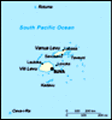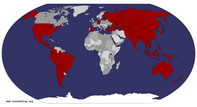Advertisement
Published: April 9th 2010
(Day 735 on the road) "This bus is
alwayson Fiji-time, mister!" The young Indian woman gave me her widest smile, exposing her perfect teeth. I was in the predominantly Indian village of Tavalu on Viti Levu's northern coast, Fiji's main island, waiting for the local bus heading east. After my disappointing stay on partying Mana Island it was time to dig a little deeper and search for the "real" Fiji. As many visitors to Fiji stay around the city of Nadi (where the international airport is located) and the adjacent islands of the Mamanucas and the Yasawas, chances were good that the rest of the country would be blissfully devoid of many visitors.
Before I start however a word on my last blog entry about my second anniversary of travelling: Thank you all for the countless comments and messages; it really means a lot to me - keep them coming! A number of people have had problems however accessing the blog (the link given on the travelblog,org website wasn't working correctly all the time), so if you weren't able to view the entry,
have a look here for the highlights of my second year on the road. But back to Fiji: So there I was in Tavalu, waiting for the local bus,
armed with the biggest watermelon I could find at the local market, on my way to the island of Nananu-i-ra, a few hours to the east. I was the only tourist in town, and sitting on a downtown street corner the previous day, exchanging countless "Bulas!" and chatting with the curious locals it felt light-years away from the intense touristy party-vibe of the Mamanuca islands.
Tavalu is made up of a nearly 100% Indian population, with very few indigenous Fijians around. Only 57% of the population in Fiji are actually Fijians, whereas 37% are Indian-Fijians. They came over as quasi-slaves during the time of the British colonial rule in Fiji, when additional labourers were needed to work on the plantations here. They were called "indentured workers" and were shipped over from India, mainly from the lower and uneducated casts, and had been promised high pay and good working conditions. Little did they know that they had signed a three-year contract that forced them to work long hours without salary just to pay off the passage from India to Fiji. After three years, they could either stay or work for another three years for no or little pay to earn
the return-fare to India. Not surprisingly, most stayed.
However, never did the Fiji-Indians receive equal rights in Fiji; in fact, they are not even allowed to call themselves Fijians (even if they were born here) or own freehold land. Racial tension is running high as one can imagine. On top, Indians seem considerably more adept at doing business, often owning most of the shops in a town, arousing envy from Fijians, who seem less entrepreneurial.
My thoughts were interrupted when the bus finally came to a halt in front of me, and a few hours later the driver dropped me off in the middle of nowhere so I could catch a boat across to Nananu-i-ra from a nearby landing. Very much in the middle of nowhere in fact, as the driver had forgotten all about me and only remembered five kilometres further along. My lovely, enormous watermelon soon became a huge burden, as I trotted back along the road for an hour to the landing. Ah, the joys of travelling.
The island of Nananu-i-ra was blissfully quiet, just what I had been looking for. The owner of the hostel I stayed in seemed more than pleased to
see me (I was her only guest); she gave me a fresh papaya as a welcome gift and a huge en-suite rooms with its own well-equipped kitchen for the price of the dormitory - what more could I ask for? I spent two relaxed days there, at one point walking around the whole island.
My friendly landlady had told me it would be a one-hour walk, but when I was still scrambling over rocks and across beaches four hours later I knew that we had somehow had a miscommunication. In the end, I managed to hitch a ride on a local boat that saved me another two hours or so of walking, making it back to my hostel just before sunset. Unfortunately, as with Mana Island, the beaches were nothing to go wild about, with (man-made) rubbish lying around everywhere, and the water and beaches covered in seaweed and algae.
On Nananu-i-ra I received a tip about a beautiful island called Caqalai (pronounced Thangaly), off the east coast of Viti Levu. With nothing else planned at all I was soon on my way, and a few hours later I was waiting by a river landing for the boat
to take me across. However, the boat that had been promised to me over the phone for two o'clock didn't show up until five-thirty. Fiji-time at its best.
I have been wondering for a long time just how much this laissez-faire attitude (call it Fiji-time or whatever you like in other countries) hinders the development of a country. The cost and uncertainties of doing business in places where things just don't work smoothly must be enormous, with dire effects on the economy and the development of the country. It would be really interested to see some statistics on this matter.
Caqalai Island however was worth the wait (even though there was the omni-present rubbish lying around everywhere). Being somehow run as a community project by the Methodist Church and the ten local village on the adjacent island of Moturiki (I didn't quite understand the complete setup), it attracted a decidedly different crowd than other islands.
I soon found myself chatting to a diverse range of highly interesting people. Amongst others there was a German girl who works for the United Nations in Bangkok and was surveying local villages in Fiji on climate change, two French girls working
at the French embassy in Suva, another French girl who teaches French at the University of the Pacific, and a girl from Papua New Guinea that works for the Pacific Islands Forum Secretariat in Fiji. After a few days I also undertook the strenuous and long walk around the island, taking me the better part of ten minutes.
The days came and went; I was happy. On Easter Sunday, a few of the staff on the island were going over to the village of Nubasaga on the bigger island of Maturiki to attend church and asked if I cared to join them. What a question! Fiji is deeply religious, with the Methodist church attracting the most supporters, simply because they had the first missionaries in Fiji. The service itself was lengthy and didn't capture my imagination - it being in Fijian didn't help much, and neither did the fact that the preacher tended to disappear for long intervals behind his chancel, so that only his voice could be heard. Weird!
But observing life in the village, meeting the chief and seeing the villagers dress up for church (men for instance would wear a Fijian-type long skirt paired with
a dress-shirt and tie, but no shoes) was fascinating. Their main source of income is from growing and selling Kava roots (made into a popular drink in Fiji) and fishing. And when they sell a particularly good catch, they often stop working altogether until the money is spend, often for weeks on end. I am not sure if I should envy them or not.
One thing that really puzzles me about Fiji (and all other travellers I have talked to) are the costs of things on Fiji. In short, they are often ridiculously high. A scrubby 12-bed dorm with dirty sheets in a run-down hostel with no facilities whatsoever (no hot showers, no electricity except for a few hours at night when the generator is switched on etc) often set me back a cool 12 Euros. That is the same price I usually paid in New Zealand, for a really nice, sparking-clean hostel, with all the amenities of a modern hostel these days (four-bed dorm, fully-equipped kitchen, huge TV with DVD library, Internet, laundry, cosy lounge etc). And it is not like the hostels on native Fijian land have to pay rent or high council tax.
To put
this into perspective: In Fiji, 50% of the population lives below the poverty line, a boat captain, cook or taxi driver earns 25 Euros a week, and the cost of things away from the tourist trail is often very cheap indeed. So the big question is: Where does all the money go that the 500.000 annual tourists cough up? My feeling is that the select few working with tourists are doing extremely well, whilst the money does seldom if ever reach the population at large.
From Caqalai, I headed over to the island of Ovalau, exploring its colonial town of Levuka and the interior village of Lovoni, situated smack-bang in the centre of a massive crater that was formed when a volcano erupted here a long time ago, creating the island. I spent some time there with two American Peace Corps volunteers, who told me stories of rampant domestic violence in the Fijian villages the worked in, a fact that I had also read about in my guidebook. I was pretty stunned nevertheless, as all the Fijians I have met so far were exceptionally nice. As often, things are not always what the appear to be I guess. For
my last few days in Fiji I went to have a look at the capital, Suva (and its great Fiji Museum), before making my way back to Nadi for one final day in the country, which I mostly spent on the Airport Golf Course where Vijay Singh used to work as a caddy and play golf in his youth before becoming famous.
Well, and this already concludes my two short weeks on Fiji. Whilst I didn't find the pacific paradise I had been somehow expecting, I was intrigued by the rich culture and unique customs of the islands. Until the early 19th century, Fiji had been mostly unexplored due to the treacherous shallow reefs in the region that kept explorers away, whilst the geographic isolation of many of its 333 islands has further added to the development of distinct customs, even different languages. Widow strangulation, for instance, is still being practiced amongst certain tribes to this day, whereas the widow is killed by strangulation upon her husband's death so that their souls can escape to heaven together. I would love to come back one day and really explore the more remote islands of the archipelago (and the neighbouring pacific countries of course), many of which can only be reached by cargo boats that often run only once a month, or by expensive charter planes.
But looking for the perfect beach, I would head back to southeast Asia anytime. If I had come to Fiji on an expensive two week vacation all the way from Europe and found the seaweed-covered sea and beaches combined with the amount of man-made rubbish everywhere that I have seen here, I would be more than disappointed to have spent so much money. Then again, maybe I was just unlucky in my choice of islands - the perfect Fijian beach that I have always seen on postcards got to be out there somewhere. Bula!
Next stop: Honolulu (Oahu, Hawaii, USA).
To view my photos, have a look at
pictures.beiske.com. And to read the full account of my journey, have a look at the complete
book about my trip at Amazon (and most other online book shops).

Advertisement
Tot: 0.434s; Tpl: 0.013s; cc: 42; qc: 164; dbt: 0.2481s; 1; m:domysql w:travelblog (10.17.0.13); sld: 1;
; mem: 1.6mb















alan
non-member comment
Nice
Great post Ben. Really enjoyed the pics and videos! :-D Travel safe. AL